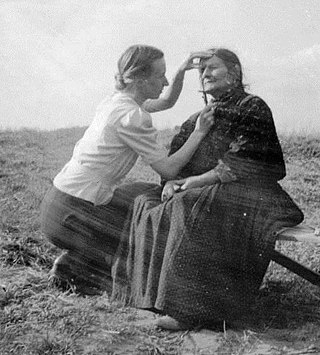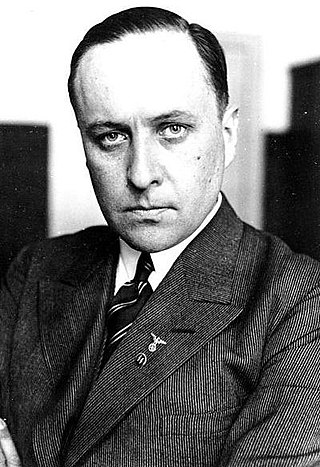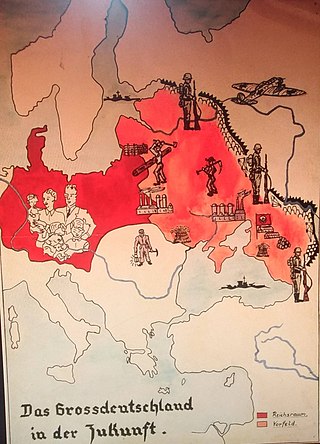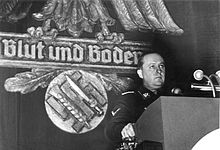
Lebensraum is a German concept of expansionism and Völkisch nationalism, the philosophy and policies of which were common to German politics from the 1890s to the 1940s. First popularized around 1901, Lebensraum became a geopolitical goal of Imperial Germany in World War I (1914–1918), as the core element of the Septemberprogramm of territorial expansion. The most extreme form of this ideology was supported by the Nazi Party and Nazi Germany. Lebensraum was a leading motivation of Nazi Germany to initiate World War II, and it would continue this policy until the end of the conflict.

The racial policy of Nazi Germany was a set of policies and laws implemented in Nazi Germany under the dictatorship of Adolf Hitler, based on pseudoscientific and racist doctrines asserting the superiority of the putative "Aryan race", which claimed scientific legitimacy. This was combined with a eugenics program that aimed for "racial hygiene" by compulsory sterilization and extermination of those who they saw as Untermenschen ("sub-humans"), which culminated in the Holocaust.

The Enabling Act of 1933, officially titled Gesetz zur Behebung der Not von Volk und Reich, was a law that gave the German Cabinet – most importantly, the Chancellor – the power to make and enforce laws without the involvement of the Reichstag or Weimar President Paul von Hindenburg, leading to the rise of Nazi Germany. Critically, the Enabling Act allowed the Chancellor to bypass the system of checks and balances in the government.

The Constitution of the German Reich, usually known as the Weimar Constitution, was the constitution that governed Germany during the Weimar Republic era (1919–1933). The constitution declared Germany to be a democratic parliamentary republic with a legislature elected under proportional representation. Universal suffrage was established, with a minimum voting age of 20. The constitution technically remained in effect throughout the Nazi era from 1933 to 1945 as well as during the Allied occupation of Germany from 1945 to 1949, though practically it had been repealed by the Enabling Act of 1933 and thus its various provisions and protections went unenforced for the duration of Nazi rule, and after World War II, the power of the Allied Control Council and four occupying powers once again stood above the provisions of the constitution.

Wilhelm Stuckart was a German Nazi Party lawyer, official, and a State Secretary in the Reich Interior Ministry during the Nazi era. He was a co-author of the notorious Nuremberg Laws and a participant in the January 1942 Wannsee Conference, at which the genocidal Final Solution to the Jewish Question was planned. He also served as Reichsminister of the Interior in the short-lived Flensburg government at the end of the Second World War.

Richard Walther Darré was one of the leading Nazi "blood and soil" ideologists and served as Reich Minister of Food and Agriculture. As the National leader for agricultural policy, he was a high-ranking functionary in the Nazi Party and as a Senior group leader in the SS, he was the seventh most senior commander in that organisation. He was tried and found guilty on three counts at the Ministries Trial.

The flag of Nazi Germany, officially the flag of the German Reich, featured a red background with a black swastika on a white disc. This flag came into use initially as the banner of the Nazi Party (NSDAP) after its foundation. Following the appointment of Adolf Hitler as Chancellor in 1933, this flag was adopted as one of the nation's dual national flags, the other being the black-white-red triband of the German Empire.

Blood and Soil is a nationalist slogan expressing Nazi Germany's ideal of a racially defined national body ("Blood") united with a settlement area ("Soil"). By it, rural and farm life forms are idealized as a counterweight to urban ones. It is tied to the contemporaneous German concept of Lebensraum, the belief that the German people were to expand into Eastern Europe, conquering and displacing the native Slavic and Baltic population via Generalplan Ost.
Heroic realism is art used as propaganda. Examples include the Socialist realism style associated with Socialist states, and sometimes the similar art style associated with Fascism. Its characteristics are realism and the depiction of figures as ideal types or symbols, often with explicit rejection of modernism in art.

The Nuremberg Laws were antisemitic and racist laws that were enacted in Nazi Germany on 15 September 1935, at a special meeting of the Reichstag convened during the annual Nuremberg Rally of the Nazi Party. The two laws were the Law for the Protection of German Blood and German Honour, which forbade marriages and extramarital intercourse between Jews and Germans and the employment of German females under 45 in Jewish households; and the Reich Citizenship Law, which declared that only those of German or related blood were eligible to be Reich citizens. The remainder were classed as state subjects without any citizenship rights. A supplementary decree outlining the definition of who was Jewish was passed on 14 November, and the Reich Citizenship Law officially came into force on that date. The laws were expanded on 26 November 1935 to include Romani and Black people. This supplementary decree defined Romanis as "enemies of the race-based state", the same category as Jews.
An order, line or right of succession is the line of individuals necessitated to hold a high office when it becomes vacated, such as head of state or an honour such as a title of nobility. This sequence may be regulated through descent or by statute.

Anti-Jewish legislation in pre-war Nazi Germany comprised several laws that segregated the Jews from German society and restricted Jewish people's political, legal and civil rights. Major legislative initiatives included a series of restrictive laws passed in 1933, the Nuremberg Laws of 1935, and a final wave of legislation preceding Germany's entry into World War II.

The Reich Chamber of Film was a government agency which operated as a statutory corporation controlled by the Ministry of Public Enlightenment and Propaganda that regulated the film industry in Nazi Germany between 1933 and 1945. Membership in the association was obligatory for everyone in the German Reich who wanted to work on films in any capacity; lack of membership meant in effect a ban on employment. Based in Berlin, the establishment of the RFK was an important element of the Gleichschaltung process and Nazi film policy.
The Artaman League was a German agrarian and völkisch movement committed to a Back-to-the-land–inspired ruralism, founded in 1923. Active during the inter-war period, the League became closely linked to, and eventually absorbed by, the Nazi Party.

Wehrbauer, plural Wehrbauern, is a German term for settlers living on the marches of a realm who were tasked with holding back foreign invaders until the arrival of proper military reinforcements. In turn, they were granted special liberties. Wehrbauern in their settlements, known as Wehrsiedlungen, were mainly used on the eastern fringes of the Holy Roman Empire and later Austria-Hungary to slow attacks by the Ottoman Empire. This historic term was resurrected and used by the Nazis during the Second World War.

The propaganda of the Nazi regime that governed Germany from 1933 to 1945 promoted Nazi ideology by demonizing the enemies of the Nazi Party, notably Jews and communists, but also capitalists and intellectuals. It promoted the values asserted by the Nazis, including heroic death, Führerprinzip, Volksgemeinschaft, Blut und Boden and pride in the Germanic Herrenvolk. Propaganda was also used to maintain the cult of personality around Nazi leader Adolf Hitler, and to promote campaigns for eugenics and the annexation of German-speaking areas. After the outbreak of World War II, Nazi propaganda vilified Germany's enemies, notably the United Kingdom, the Soviet Union and the United States, and in 1943 exhorted the population to total war.

The Reichsnährstand or 'State Food Society', was a government body set up in Nazi Germany to regulate food production.
The Control Council Law No. 1 – Repealing of Nazi Laws was a law enacted by the Allied Control Council for post-World War II Germany on 20 September 1945.

The Reich Harvest Thanksgiving Festival was a monumental Nazi German celebration of the peasantry and the German farmers. The festivals ran from 1933 to 1937 on the Bückeberg, a hill near the town of Hamelin. Most festivals occurred every October, with the 1934 festival commencing 30 September. The official purpose of the festival was the recognition of the achievements of the German farmers, whom the Nazis called the Reichsnährstand. The celebration was also used by the Nazis as a propaganda tool to showcase the connection between Führer Adolf Hitler and the German people. The festival was part of a cycle of Nazi celebrations which included the annual party rally at Nuremberg, Hitler's birthday celebrations and other important events on the Nazi calendar.

Beginning in 1925, some members of higher levels of the German nobility joined the Nazi Party, registered by their title, date of birth, NSDAP Party registration number, and date of joining the Nazi Party, from the registration of their first prince (Ernst) into NSDAP in 1928, until the end of World War II in 1945.















